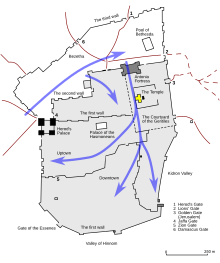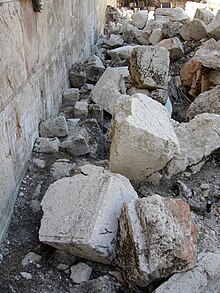Conquest of Jerusalem (70 AD)
The conquest of Jerusalem in the Jewish War in 70 was an important event in the history of the Jewish people. The Jerusalem temple was destroyed, its cult objects looted and later carried along in the triumphal procession in Rome. For the Romans, the capture of Jerusalem marked the strategic triumph over Judea , which was completed with the capture of the palace fortress Masada in 73 or 74.
prehistory
In May of the year 66 the Jewish Zealots began a revolt against the Roman occupation in Judea and were able to achieve some initial successes. As a result, the Roman emperor Nero sent an army under the command of Vespasian in October to end the unrest in Judea. His 26-year-old son Titus accompanied him. Vespasian was given the three legions Legio V Macedonica , Legio X Fretensis and Legio XV Apollinaris . Titus commanded as legate , the fifteenth legion. In total, Vespasian, including auxiliary troops, had an army of around 60,000 men. The size of the army and the important position of the still quite inexperienced Titus, who had not even been praetor before, show the trust that the emperor still placed in the two Flavians . In 67 Vespasian was able to end the uprising in Galilee , Transjordan and in the coastal strip. Judea was thus surrounded on three sides.
In the summer of 68, Nero committed suicide. There was turmoil in the Roman Empire, which is known as the year of the Four Emperors (69). At the end of this, Vespasian was proclaimed the new emperor because he could rely on the support of the governors and legions of the Orient. He returned to Rome to secure the imperial throne for himself. Titus stayed behind in Judea, negotiating with the commanders of the legions stationed there, keeping his father's back free. He should bring the campaign to an end.
Intra-Jewish disputes
Many rebels from Galilee fled to Jerusalem. The disputes between the various resistance groups soon escalated. Basically, two camps faced each other: those who wanted to continue fighting and the moderates around the high priest who wanted to negotiate. Eventually Johanan ben Levi invaded the temple precinct , called for an end to the negotiations, and accused the high priest and moderates of failure and treason. The high priest and his followers were able to arrest the extremists on the Temple Mount. But Johanan ben Levi and his comrades managed to break free. They captured the moderates and later killed them. The temple precinct was like a bloody battlefield. In the power vacuum that arose after the death of the moderate leaders and the high priest, rival extremists, including Zealots , Sicarians , Sadducees and Idumeans , fought for supremacy in Jerusalem. Around 25,000 people defended Jerusalem, protected by gigantic fortifications.
The siege
Titus began the siege of Jerusalem in March 70, exactly on the day of Passover . According to Flavius Josephus , the former Jewish military commander of Galilee who accompanied Titus, around 3 million people were in the city. Titus reached the city with the Legio XII Fulminata and the Legio XV Apollinaris from the north and set up his camp in the west. There he was joined by the Legio V Macedonica coming from Emmaus. The Legio X Fretensis coming from Jericho camped in the east on the Mount of Olives.
Titus successfully used the entire arsenal of Roman siege weapons from towers, catapults , onagers, and battering rams . With it his legions broke through the outer two of three walls in the west of the city in less than four weeks and invaded the northern suburbs.
The conquest
In the conquered New Town behind the third wall, Titus set up his second camp. In mid-June, the attempt to capture Antonia Castle was initially repulsed by the defenders. At the beginning of July, Titus had a siege wall about 8 km long built around the not yet conquered part of Jerusalem. A famine broke out in Jerusalem. From July 20-22, 1970, when the Romans attacked again, Antonia Castle, north of the temple square, was captured and burned down. This strategically important point enabled control of the temple precinct.
The inner city and the temple withstood the siege until early August. After the soldiers had reached the outer courtyard of the temple, they burned the structure and killed everyone who had not previously died of lack of food or of suicide.
“Some of them voluntarily fell into the swords of the Romans, others killed each other, others killed themselves, and still others jumped into the flames. And it seemed to mean not so much ruin for everyone but rather victory and salvation and grace to go down with the temple. "
On August 30th, the Romans conquered the upper and lower city with the palace of Herod. Smaller groups of Jewish fighters escaped through hidden tunnels. On September 7, 1970, the city was completely in Roman hands. According to Flavius Josephus, around 1.1 million people were killed in the conquest, most of them Jews.
Further development
The siege of Jerusalem had shown that Titus, though a little innovative, was a very capable general. He spent the winter following the conquest playing gladiatorial games and punishing surviving prisoners. In June 71 he returned to Rome as emperor . He and his father celebrated the lavish triumph over Judea there. The Arch of Titus in the Roman Forum is a reminder of this .
consequences
The temple was destroyed - probably by accident - and has not been rebuilt to this day. Only the western wall was preserved. The Jews remember the destruction of the temple on the fasting day of Tisha beAv . With the capture of Jerusalem, the campaign in Judea was essentially over. The last rebels, who had withdrawn in the mountain fortress Masada after the fall of the city , were able to oppose the Roman legions until 73. However, the danger they posed to the success of the campaign was not great. For the Jewish population, the conquest of the city meant the final loss of political autonomy. Many left the city. The efforts to reorganize religious life, which were already evident before the war, were implemented under the impression of the new conditions. It came to form the rabbinic Judaism , because as a result of the destruction of the temple ended the sacrificial cult , and the Office of the High Priest lost his footing. The Sanhedrin as an organ of Jewish self-government was moved to Jawne . The since 44 BC The existing Roman province of Judaea was given a governor of praetorical rank with a permanently stationed legion.
swell
- Otto Michel , Otto Bauernfeind (ed.): Flavius Josephus: De bello Judaico. The Jewish War. Bilingual edition of the seven books . 3 volumes, Wissenschaftliche Buchgesellschaft, Darmstadt 1959–1969 (critical edition with limited equipment)
literature
- Baruch Lifshitz: Jérusalem sous la domination romaine. Histoire de la ville depuis la conquête de Pompée jusqu'à Constantin (63 a. C. - 325 p. C.). In: Political History (Provinces and Fringe Peoples: Syria, Palestine, Arabia) , Rise and Fall of the Roman World, Volume 8 (1978), pp. 444–489.
- Klaus Bringmann : History of the Jews in Antiquity. From the Babylonian exile to the Arab conquest. Klett-Cotta, Stuttgart 2005, ISBN 3-608-94138-X .
- Christopher Weikert: From Jerusalem to Aelia Capitolina. The Roman policy towards the Jews from Vespasian to Hadrian (= Hypomnemata. Volume 200). Vandenhoeck & Ruprecht, Göttingen 2016
- Jonathan J. Price: Jerusalem under Siege: The Collapse of the Jewish State, 66-70 CE (= Brill's series in Jewish studies. Vol. 3). Brill, Leiden 1992, ISBN 90-04-09471-7 .
- Steve Mason: A history of the Jewish War: AD 66-74. Cambridge University Press. Cambridge / New York 2016.
- Martin Goodman: Rome and Jerusalem: The Clash of Ancient Civilizations. Allen Lane, London 2007.
Web links
- Josephus' Jewish War (Greek and English translation in the Perseus Project )
Remarks
- ↑ Flavius Josephus, Jüdischer Krieg 6,420 ( English ).
- ^ Translation after Karl Christ : History of the Roman Empire. From Augustus to Constantine. 6th edition with updated bibliography. Beck, Munich 2009, ISBN 978-3-406-59613-1 , p. 252.
- ^ Hubert Frankemölle : Early Judaism and Early Christianity. Prehistory-course-effects (4th century BC to 4th century AD). W. Kohlhammer, Stuttgart 2006, ISBN 978-3-17-019528-8 , pp. 269-270.


